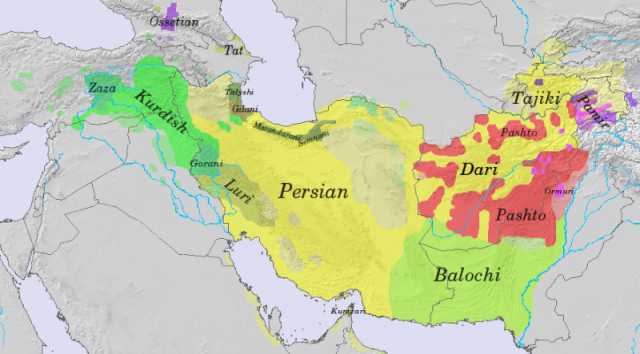
| PAMIR LANGUAGES Pamir languages
(ethnically defined)
Ethnicity : Pamiris
Geographic distribution : Pamir Mountains
Linguistic classification :
Indo-European
Glottolog :
Shug1237 (Shughni-Yazgulami)
Yidg1239 (Munji-Yidgha)
Sang1316 (Sanglechi-Ishkashimi)
Wakh1245 (Wakhi)
The Pamir languages are an areal group of the Eastern Iranian languages, spoken by numerous people in the Pamir Mountains, primarily along the Panj River and its tributaries.
In the 19th and early 20th centuries, the Pamir language family was sometimes referred to as the Ghalchah languages by western scholars. The term Ghalchah is no longer used to refer to the Pamir languages or the native speakers of these languages.
One of the most prolific researchers of the Pamir languages was Soviet linguist Ivan Ivanovich Zarubin.
Geographic distribution :
Map of modern Iranian languages. The Pamir languages are spoken in the extreme east of the distribution, in the purple-shaded area The Pamirian languages are spoken primarily in the Badakhshan Province of northeastern Afghanistan and the Gorno-Badakhshan Autonomous Region of eastern Tajikistan.
Pamirian languages are also spoken in Xinjiang and the Pamir language Sarikoli is spoken beyond the Sarikol Range on the Afghanistan-China border and thus qualifies as the easternmost of the extant Iranian languages.
Wakhi communities are also found in the adjacent Chitral District, Khyber Pakhtunkhwa and in Gojal, Gilgit Baltistan in Pakistan.
The only other living member of the Southeastern Iranian group is Pashto.
Classification
:
Members of the Pamirian language area include four reliable groups: a Shughni-Yazgulyam group including Shughni, Sarikoli, and Yazgulyam; Munji and Yidgha; Ishkashimi and related dialects; and Wakhi. They have the subject-object-verb syntactic typology.
Subgroups
:
The Vanji language was spoken in the Vanj river valley the Gorno-Badakhshan Autonomous Region in Tajikistan, and was related to Yazgulyam. In the 19th century, the region was forcibly annexed to the Bukharan Emirate and a violent assimilation campaign was undertaken. By the end of the 19th century the Vanji language had disappeared, displaced by Tajik Persian.
Most language speakers and others in Tajikistan refer to languages in this group as 'Pamirski" or 'Pamir'. (e.g. "I can speak Pamir, Ishkashem and Wakhi")
Munji-Yidgha
branch :
Sanglechi-Ishkashimi
:
Wakhi
:
Status
:
Source :
https://en.wikipedia.org/ |
